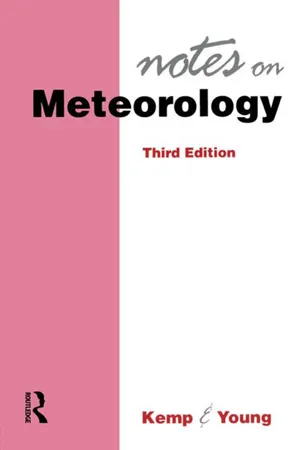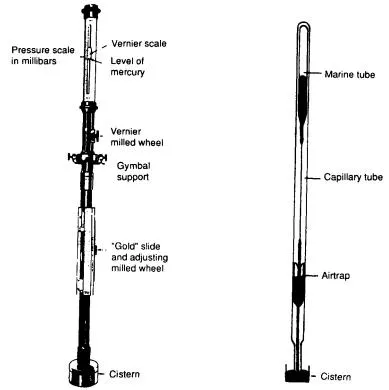
- 112 pages
- English
- ePUB (mobile friendly)
- Available on iOS & Android
eBook - ePub
Notes on Meterology
About this book
Part of the Kemp and Young series, this book provides a concise introduction to meteorology. Information is presented using diagrams, illustrations and worked examples. Mathematics is kept to a necessary minimum and there is a comprehensive index to aid quick reference. Notes on Meteorology is suitable for First Officer or Master Marine certification exams, those new to sea faring, and those whose practical experience is limited to narrow areas and wish to expand their knowledge.
Frequently asked questions
Yes, you can cancel anytime from the Subscription tab in your account settings on the Perlego website. Your subscription will stay active until the end of your current billing period. Learn how to cancel your subscription.
No, books cannot be downloaded as external files, such as PDFs, for use outside of Perlego. However, you can download books within the Perlego app for offline reading on mobile or tablet. Learn more here.
Perlego offers two plans: Essential and Complete
- Essential is ideal for learners and professionals who enjoy exploring a wide range of subjects. Access the Essential Library with 800,000+ trusted titles and best-sellers across business, personal growth, and the humanities. Includes unlimited reading time and Standard Read Aloud voice.
- Complete: Perfect for advanced learners and researchers needing full, unrestricted access. Unlock 1.4M+ books across hundreds of subjects, including academic and specialized titles. The Complete Plan also includes advanced features like Premium Read Aloud and Research Assistant.
We are an online textbook subscription service, where you can get access to an entire online library for less than the price of a single book per month. With over 1 million books across 1000+ topics, we’ve got you covered! Learn more here.
Look out for the read-aloud symbol on your next book to see if you can listen to it. The read-aloud tool reads text aloud for you, highlighting the text as it is being read. You can pause it, speed it up and slow it down. Learn more here.
Yes! You can use the Perlego app on both iOS or Android devices to read anytime, anywhere — even offline. Perfect for commutes or when you’re on the go.
Please note we cannot support devices running on iOS 13 and Android 7 or earlier. Learn more about using the app.
Please note we cannot support devices running on iOS 13 and Android 7 or earlier. Learn more about using the app.
Yes, you can access Notes on Meterology by Richard Kemp,Young,Kemp in PDF and/or ePUB format, as well as other popular books in Physical Sciences & Geography. We have over one million books available in our catalogue for you to explore.
Information
CHAPTER ONE
Instruments
In order to get as complete a picture as possible of the weather, careful observations should be made of the individual phenomena which go to make up the weather. Many of these observations are made visually: for example, the form of clouds, and direction of the wind. Others must be made by instruments; for instance one cannot ‘feel’ the pressure or the relative humidity although one may hazard a guess at the air temperature.
Various instruments have been designed to observe the different phenomena. The principal ones measure pressure, temperature and wind velocity, whilst others have been designed to measure sunshine hours and rainfall.
There is no necessity for a ship to carry every instrument, as a barometer and a hygrometer together with the broadcast weather information will enable one to make an accurate forecast for the next few hours. The Meteorological Office recognises this and usually supplies a precision aneroid or a mercurial barometer, a barograph, a sea thermometer and a hygrometer to observing ships.
Pressure and its measurement
Pressure is force per unit area. The unit of pressure in the Si system is the bar which is approximately equivalent to a load of 10 tonnes weight per square metre (10 tf/m2).
The average pressure at ground level is slightly in excess of 1 bar and to avoid the necessity of having large numbers of figures after the decimal point in order to express pressure accurately, the bar is divided into 1000 parts. Each of these parts is a millibar, and pressure is expressed in these units.
For many years pressure was also expressed in millibars under the Imperial system although it was also, and still may be, expressed as ‘inches of mercury’. This is the length of a column of mercury which will balance a column of air. As the column of air exerts a pressure of approximately 14.71b per square inch the height of the column of mercury (relative density 13.6) necessary to exert this pressure is about 30 in.
Isobar A line joining places having equal pressure. On weather charts these are plotted at 4 millibar intervals, so that the isobars shown are divisible by 4.
Isallobar A line joining places having an equal change of pressure. A study of these can give an indication of the direction of movement of pressure systems.
Pressure gradient This is the difference in pressure in unit distance measured at right angles to the isobars.
There is a diurnal range of barometric pressure which results in the barometric pressure being higher than normal at 1000 and 2200 local time and lower than normal at 0400 and 1600 local time. The semi-diurnal pressure wave is due to the atmospheric tides which are caused by the sun and moon. It is possible that there are other causes, as this semi-diurnal change of pressure is still being investigated.
The diurnal range is most marked in the tropics where the barometer is frequently 1.5 millibars above or below normal at the times mentioned above. It is less noticeable in higher latitudes where frequent pressure changes occur due to the passage of depressions. However, when the pressure gradient is constant and small, this daily range may be seen clearly on a barograph trace although the variation is very much less than in low latitudes.
Mercurial barometer (Figure 1)
This is constructed by filling a tube, about 1 metre (39 in) long with mercury. The end of the tube is temporarily closed and is inverted and placed into a reservoir of mercury. When the closure is removed it will be seen that the level of mercury falls in the tube. The space above the mercury at the top of the tube is known as a Torricellian vacuum (after Torricelli). If an air bubble were to get into this space it would depress the mercury (as the vacuum would no longer be complete) and an incorrect reading would result. To prevent this, an air trap is incorporated in the tube. A further refinement in the Kew pattern marine barometer is the capillary tube between the air trap and the marine tube (Figure 1(b)). The mercurial barometer is liable to error on account of the following:
1 Capillarity. The surface tension of the mercury forms a meniscus and readings should always be taken at the top of this.
2 Capacity. The height of the barometer should be taken from the top of the mercury in the cistern to the top of the mercury in the marine tube. If the pressure increases, the level of the mercury in the cistern falls, so that the measurements cannot be taken from a fixed point. This error is compensated by adjusting the distance between the graduations. On the inch barometer the barometer inch will be seen to be 24/25ths of a linear inch. (In the Fortin barometer used in laboratory work the level of mercury in the cistern is adjustable so that the readings can always be taken from the same level.)

Figure 1 (a) Mercurial barometer (b) Kew pattern marine barometer
3 Pumping. Due to the constant change in height above mean sea level of a barometer on a vessel in a seaway, there will tend to be a continual change of reading. This movement of the mercury will make it difficult to get an accurate reading. Gusty winds can also cause pumping. The effect of pumping is considerably reduced by fitting the capillary tube above the air trap. (If pumping is present, try to get a mean of the highest and lowest readings.)
4 Height. All readings should be corrected to sea level. Increase of height means a decrease of pressure by approximately 1 millibar for every 10 m (30 ft). This correction can be made by tables or by the Gold Slide.
5 Latitude. Due to the earth being somewhat ‘flattened’ at the poles, mercury weighs more at the poles than at the equator. For equal atmospheric pressures the barometer would appear to read less at the poles and more at the equator. Readings should all be corrected for a mean latitude of 45°. The correction can be made by tables or by the Gold Slide (see below).
6 Temperature. The column of mercury will expand with an increase of temperature and contract with a decrease of temperature in exactly the same way as does a thermometer. All readings must be reduced to a standard temperature which is 285 K in the case of most millibar barometers and 28.6°F in the case of inch barometers. The correction can be made by tables or by the Gold Slide.
N.B. The attached thermometer should always be read before the barometer as otherwise heat from the observer’s body may give a false reading.
The temperature at which a barometer reads correctly is known as the Fiducial Temperature. In lat. 45° at sea level this is the same as the standard temperature, but at sea level in lat. 57° the fiducial temperature would be 291K, and in lat. 21° at sea level it would be 273 K. At 20 m (60 ft) above sea level in 45° it would be...
Table of contents
- Cover
- Half Title
- Title Page
- Copyright Page
- Table of Contents
- Preface to first edition
- Preface to revised edition
- 1 Instruments
- 2 The atmosphere
- 3 Cloud and precipitation
- 4 Wind
- 5 Isobaric systems
- 6 Tropical storms
- 7 Currents and ice
- 8 Weather charts and routeing
- Index